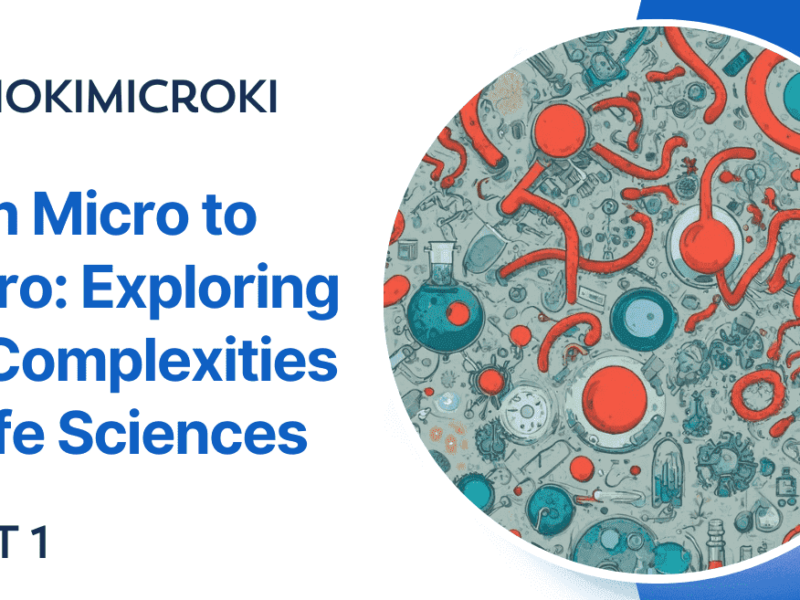Microbiology is a field of Life Sciences which deals with the study of all living organisms which are too small to be observed by the naked eye. The name Microbiology is self-explanatory, where Micro means extremely small and biology is the field of life sciences.
| DO YOU KNOW? You are never alone – From the time you are born, the microbes are all around you. These tiny microbes are present inside our body and on our body surface. Our body is like universe to these microbes. We carry trillions of microorganisms in and on our body. These microorganisms affect every part and function of our body. Such is the level of their reach that several studies and research have demonstrated that our social and emotional behaviour is also affected by these microbes. The microorganisms present in our gut are called as Microbiota, who play a pivotal role in digesting our food. They influence our food cravings, obesity, diseases, and mental health. And hence, not all microorganisms are our enemy, some play a crucial role in being who we are. Let us learn more about them… |
What is Microbiology?
It is the branch of Biological science that deals with the study of microscopic organisms or microorganisms. Microorganisms are those organisms which cannot be seen by our unaided or naked eyes. As the prefix suggest, these organisms are micro in size i.e. 10 -6 m and therefore called micro-organism. The human eye is capable of seeing things or organisms which are upto 0.1mm size.

However, some microorganisms are visible to us. Ex. Bread mould, which you might have seen on your bread that grows on it when you forget to keep it in the refrigerator. Such visible organisms are called as Macro-organism.
What are the aims/purposes of Microbiology?
- To understand the microbial world.
- To isolate and characterise the microorganisms.
- To explore friendly microorganisms and use them for the betterment of Society.
- To study the pathogenic organism and understand their mechanism of infection.
- To Develop the strategy and technique against pathogenic microorganism.
Microbes are our ancestors:
It is said that the life on earth was initiated almost 4.5 to 4.6 billion years ago. According to the Big Bang Theory, the first life form which appeared on earth was a prokaryotic cell, and hence they are our most primitive ancestor. Scientists hypothesized that this first life form was formed due to the enclosion of organic material by a lipid membrane. It is called as Last Universal Common Ancestor, or LUCA. The LUCA was able to multiply and produce its developed copies with enhanced abilities of metabolism and multiplication.
| DO YOU KNOW? How lipid membrane might have formed around organic component to form the most premitive cell? Do you know why water was needed to start a life form on earth? Lipids are esters of fatty acids. The amphiphatic lipids means which has both ploar (hydrophilic) and non polar groups (non hydrophilic). When such amphiphatic lipids come in contact with water they spontaneously form a micelle. A micelle is a lipid molecule that arranges itself in spherical manner. The micelle formation occurs due to the aqueous environment, the polar groups of amphiphatic lipid interact with water whereas non polar groups tends to stay away from water and thus stays inside the shere. Hence, the enclosion of organic material in lipid membrane was driven water. |

In modern cells, biological and cellular functions are carried out by biomolecules like DNA, RNA, proteins, lipids and carbohydrates. But, in primitive cells these biomolecules were not available; hence, it is hypothesised that there must be single biomolecule to carry out the function like metabolism and replication. Discovery of RNA with catalytic enzyme led to the foundation of RNA world. In 1981, Thomas Cech discovered RNA from tetrahyemena (microorganism), showed replicative and catalytic property. This knowledge threw some light and allowed us to hypothesize about the RNA world. This theory believes that RNA was the hereditary material of premitive life form. The multifuntional RNA with Catalytic, replicative and with protein expression ability justify the existance of RNA world.
So, in the primitive cells, RNA was the hereditary material with storing and expressing the genetic information. But in modern cell, DNA is the hereditary material. The question arise that from where the DNA is evolved and why natured selected DNA as hereditary material over RNA?
DNA is evolved from RNA by doubling and changing the ribose to deoxy-ribose sugar. And natured selected DNA over RNA because DNA is more stable, less prone to get damaged by enzymes and more accurate in passing the information form one generation to another.
The premitive cells were anaerobic life forms because the environment was anoxic (no oxygen). The extreme and harsh envrionment allowed the existance of only extremophiles. These extremophiles are the ancestors of modern archeabacteria.
The earth got it’s first oxygen molecule when cyanobacteria was evolved. It had ability to conduct photosynthesis by using water, carbon dioxide and sunlight to form carbohydrate and oxygen. This event is called Great Oxidation event that had occurred 2.2 to 2.3 billion years ago. The evolution of cyanobacteria required multistages development from precurser pigment to cholorophyll synthesis.
Diversity of life form that we see around is because of evolution. The evolution is caused by the mutation, it is the ability of the genetic material to change its sequence. Change in genetic sequence leads to new characteristics or phenotype. The mutation could be favourable or unfavourable. The favourable mutation help the organism to adapt the environment and become fittest in the competition of survival.
Endosymbiotic theory:
This theory explains the events that caused the evolution of eukaroyotes from prokaryotes. As per this theory, the amoeba like organisms might have ingested or phagocyte other microbial cell as a nutrient. And the ingested microbial cell survived within the host (amoeba like cell) and they developed symbiotic relationship. And hence, this theory states that the engulfed microbial cell lost its ability to live alone and became host’s component. The cellular organelle like mitochondria and choloroplast present in the modern eukaryotes are evolved and obtained from engulfment of microbial cell.
Endosymbiotic theory hypothesizes that the eukaryotic organelles like mitochondria and chloroplast are evolved due to endosymbiosis. This theory is supported by the evidence that DNA and ribosome of mitochondria and chloroplast are similar to bacterial DNA and ribosome.
Microbiology has recently resurfaced as the popular choice of study options among students. And hence, it becomes pertinent to understand the significance of Microbiology and all the associated branches of life sciences.
Need more help? Click here.
If you liked this resource, please Like, Share, and Subscribe us for more content.
Dr. Sangha Bijekar has 9 years of Teaching Experience at University level. She loves to get engage in teaching and learning process. She is into blogging from last two years. She intends to provide student friendly reading material. She is avid Dog Lover and animal rescuer. She is learned Bharatnatyam and Katthak Dancer. She is into biking and She also loves to cook.


